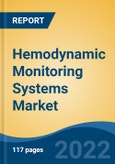Speak directly to the analyst to clarify any post sales queries you may have.
10% Free customizationThis report comes with 10% free customization, enabling you to add data that meets your specific business needs.
Technological advancements
According to recent research, it has been observed that the increasing demand for non-invasive technologies is rapidly growing over conventionally accepted invasive technology in present years. These monitoring systems help to diagnose pain and reduce the risk of blood-borne infections in patients. Similarly, these systems are easy to use and can be operated by a nurse without the supervision of a doctor or any specialist. Due to its advantages, these systems can be simultaneously monitored in different patients which lower the cost of staff and treatment expenditure. Additionally, the growing usage of hemodynamic monitoring for CVP, hemodynamic monitoring non-invasive systems, hemodynamic monitoring invasive systems, hemodynamic monitoring during CPB, hemodynamic monitoring transducers, hemodynamic monitoring transducers, hemodynamic monitoring cardiogenic shocks, hemodynamic monitoring echocardiography, hemodynamic monitoring flotrac , hemodynamic monitoring in heart failure, haemorrhage, arterial line, etc are expected to create a lucrative growth during the forecast period. Similarly, the expansion of the hemodynamic monitoring systems market and devices market are boosting the market growth rate during the forecast period. In March 2021, Philips introduced its interventional hemodynamic system featuring a patient monitor- IntelliVue X3 to provide advanced hemodynamic (blood flow) measurements and improve patient focus during image-guided procedures.Growing Prevalence of Cardiovascular Diseases
Advanced hemodynamic monitoring methods can enhance the monitoring systems of cardiac patients during post-operative care and anaesthesia - repetitive measurements for the detection of hemodynamic abnormalities and their causes. Cardiovascular diseases are one of the major chronic diseases across the world. Coronary heart syndrome, cerebrovascular diseases, rheumatic heart diseases, and other illnesses are among them blood vessel disorders known as CVDs. According to WHO, 32% of all deaths across the globe i.e., 17.9 million people die due to CVD every year. Furthermore, the increasing burden of CVDs triggers the increased adoption of hemodynamic monitoring systems during the forecast period. 96 million people aged 18 years or older have prediabetes in the United States and Nearly 1.9 million Americans have type 1 diabetes, including about 244,000 children and adolescents.Market Segmentation
The global hemodynamic monitoring system market can be segmented by product, type, end-user, and region. Based on the product, the market can be divided into Disposable and Monitors. Based on type, the market can be grouped into Invasive Hemodynamic Monitoring Systems, Minimally Invasive Hemodynamic Monitoring Systems, and Non-invasive Hemodynamic Monitoring Systems. Based on end users, the market can be segmented into Hospitals, Clinics, and Ambulatory Care Centers. Regionally, North America dominated the market among Asia Pacific, Europe, Middle East & Africa, and South America. Among the different countries, the United States dominated the global hemodynamic monitoring market on account of the growing demand for minimally invasive surgeries with low costs for the treatment of cardiovascular diseases.Recent Development
One such minimally/non-invasive Hemodynamic Monitor is made by renowned UK-based manufacturer LiDCO, the LiDCOrapid, with minimally invasive monitoring via the standard radial arterial line and one cost-effective disposable.In February 2022, Caretaker Medical received the US Food and Drug Administration (FDA) clearance to add four new parameters on its next-generation VitalStream wireless ‘beat-by-beat’ blood pressure and hemodynamic monitoring platform, to include stroke volume, cardiac output, left ventricular ejection time, and heart rate variability.
In July 2022, Retia Medical received Series B funding of $15 million led by Fresenius Medical Care Ventures to expand its commercial team and accelerate the development and commercialization of its Argos Hemodynamic Monitor.
Market Players
Edwards Lifesciences Corporation, Pulsion Medical Systems Se., Lidco Group Limited., Deltex Medical Group PLC., ICU Medical Inc., Cnsystems Medizintechnik GmbH., Caretaker Medical Inc., Osypka Medical GmbH., Cheetah Medical., NI Medical., Uscom. are some of the leading players operating in the Global Hemodynamic Monitoring System Market.Report Scope:
In this report, the global hemodynamic monitoring systems market has been segmented into the following categories, in addition to the industry trends which have also been detailed below:Hemodynamic Monitoring Systems Market, By Product:
- Disposable
- Monitors
Hemodynamic Monitoring Systems Market, By Type:
- Invasive Hemodynamic Monitoring Systems
- Minimally Invasive Hemodynamic Monitoring Systems
- Non-invasive Hemodynamic Monitoring Systems
Hemodynamic Monitoring Systems Market, By End Users:
- Hospitals
- Clinics
- Ambulatory Care Centers
Hemodynamic Monitoring Systems Market, By Region:
- North America
- United States
- Canada
- Mexico
- Europe
- France
- Germany
- United Kingdom
- Italy
- Spain
- Asia Pacific
- China
- India
- Japan
- South Korea
- Australia
- South America
- Brazil
- Argentina
- Colombia
- Middle East & Africa
- South Africa
- Saudi Arabia
- UAE
Competitive Landscape
Company Profiles: Detailed analysis of the major companies present in the Global Hemodynamic Monitoring Systems Market.Available Customizations:
With the given market data, the publisher offers customizations according to a company’s specific needs. The following customization options are available for the report:Company Information
Detailed analysis and profiling of additional market players (up to five).This product will be delivered within 1-3 business days.
Table of Contents
Companies Mentioned
- Edwards Lifesciences Corporation
- Pulsion Medical Systems Se.
- Lidco Group.
- Deltex Medical Group PLC.
- ICU Medical Inc.
- Cnsystems Medizintechnik GmbH.
- Caretaker Medical.
- Osypka Medical GmbH.
- Cheetah Medical.
- NI Medical.
- Uscom.








